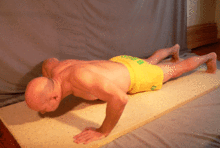Introduction
One of the most common excuses used by people that do not exercise is that they cannot afford the membership of a gym or to buy home exercise equipment. Fortunately, you don’t need to spend money on either of these to get a good muscle strengthening workout. The solution is simple and not fancy, just use your body weight as your resistance tool. By utilizing the “overload” principal of strength training (a greater than normal stress or load on the body is required for training adaptation to take place) and one’s own body weight as the load, an effective strength gaining program can be developed. Exercises such as push-ups, chin-ups, and sit-ups are some of the most commonly known and used  bodyweight strength training exercises. This form of resistance training is excellent at developing tone and endurance in the muscles. Read more…
bodyweight strength training exercises. This form of resistance training is excellent at developing tone and endurance in the muscles. Read more…
 Core, core, core, you have to strengthen your core. If there is one word that has caught the fancy of the fitness industry it is the word “core”. But what is the core, why is become so important and how best do we go about exercising our core. These are important questions that need to be answered because “the core” is vitally important for our physical health. A strong core not only improves our posture, prevents back pain, improves our balance and athletic performance but for the older adult it prevents functional disability. Read more…
Core, core, core, you have to strengthen your core. If there is one word that has caught the fancy of the fitness industry it is the word “core”. But what is the core, why is become so important and how best do we go about exercising our core. These are important questions that need to be answered because “the core” is vitally important for our physical health. A strong core not only improves our posture, prevents back pain, improves our balance and athletic performance but for the older adult it prevents functional disability. Read more…
Good posture is important for your physical and emotional health. Good posture is defined as your head, neck, shoulders, hips and feet all in proper alignment relative to each other. When a person is viewed from the side, this means that the person stands tall with the head facing forward, with the neck over the shoulders and not protruding forward. The shoulders are back, not rounded and the hips are placed over the feet. There is no excessive roundness of the upper back (khyphosis) or excessive inward curvature of the lower back (lordosis). Viewed from the front, the persons head is straight and not tilted to the right or left, the shoulders are level as are the hips. The feet point straight ahead and are not rotated out or in.
 Good posture illustrated
Good posture illustrated
Read more…
There are three dimensions of human frailty- time, disease and disuse. The passage of time is inevitable. The onset of disease is the result of internal system fatigue or external exposures that damage the body tissues. Medical technology has helped make the impact of disease significantly less. Disuse, sedentary living or lack of activity is devastating to functional capabilities and is the number one cause of human fraility. In order to improve our quality of life we must embrace physical activity.
Read more…
 bodyweight strength training exercises. This form of resistance training is excellent at developing tone and endurance in the muscles. Read more…
bodyweight strength training exercises. This form of resistance training is excellent at developing tone and endurance in the muscles. Read more…

